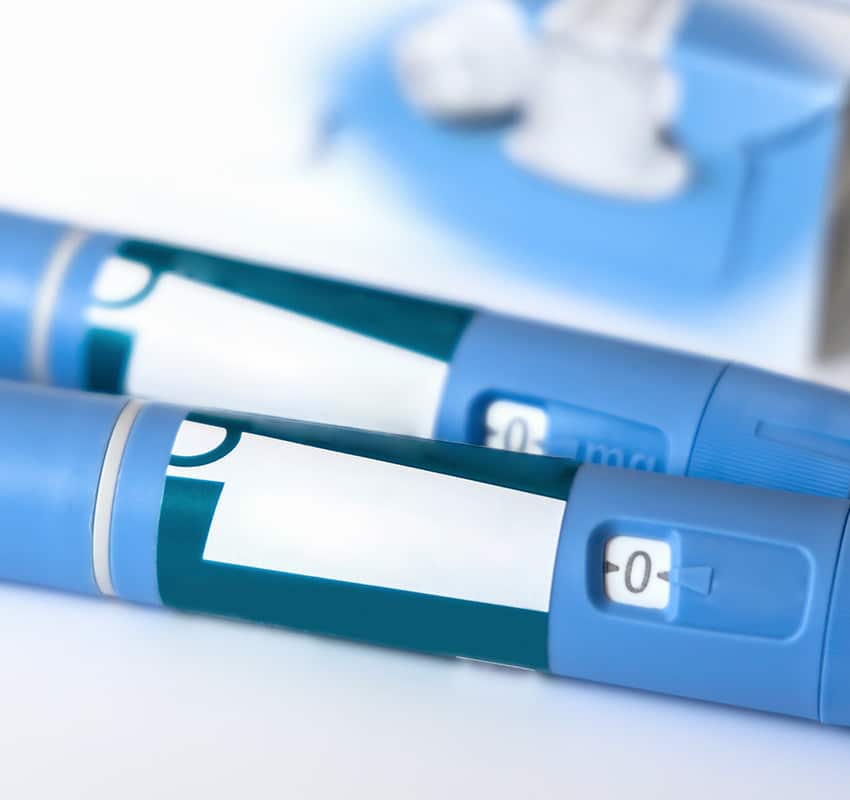GLP-1 Advertising
As diabetes is becoming more common in the world so are the ways of treating diabetes. There has been a recent surge in GLP-1 advertising because of its effective use for diabetes type 2 treatment and weight loss. Healthcare companies are investing considerably for the promotion of GLP-1 medication. Healthy Ads can help with our Contextual Solutions around GLP-1 Targeting as part of our Diabetes Targeting options.
What is GLP-1
GLP-1 is a class of drugs that is used for controlling blood sugar levels and weight of type 2 diabetic patients. These types of drugs are usually referred to as glucagon-like peptide 1 (GLP-1). Glucagon-like peptide-1, or GLP-1s, are receptor agonists that mimic the actions of the GLP-1 hormone by stimulating GLP-1 receptors in the pancreas and increasing the body’s production of insulin. In order to help manage Type 2 diabetes, insulin lowers blood sugar levels. GLP-1s have also been shown to aid in weight loss since they prolong feelings of fullness in those who take them.
How does GLP-1 work
These medications cause the body to create more insulin when blood sugar levels begin to increase after eating. The additional insulin aids in lowering blood sugar. Reducing blood sugar levels can help manage type 2 diabetes. However, it’s unclear how using GLP-1 medications causes weight reduction. Physicians are aware that GLP-1s seem to reduce appetite. Moreover, the passage of food from the stomach into the small intestine is slowed by these medications. You can feel fuller for longer as a consequence, which makes you eat less.
Apart from aiding in blood sugar regulation and promoting weight reduction, GLP-1s and SGLT-2 inhibitors appear to offer other significant advantages. Certain medications in these categories have been linked to a decreased risk of heart-related conditions, including heart failure, stroke, and renal disease. Individuals using these medications have reported improvements in their cholesterol and blood pressure. However, it’s unclear if the medicine or the weight loss is responsible for these advantages.
GLP-1 Agonists
Exenatide (Byetta, Bydureon): Available as a twice-daily injection (Byetta) or a once-weekly injection (Bydureon).
Liraglutide (Victoza, Saxenda): Saxenda is used for weight management but has the same active ingredient as Victoza, which is used once daily for diabetes.
Dulaglutide (Trulicity): A once-weekly injectable medication.
Semaglutide (Ozempic, Rybelsus): Available as a once-weekly injection (Ozempic) or a daily oral tablet (Rybelsus).
Albiglutide (Tanzeum): Was available as a once-weekly injection, but it has been discontinued in the market.
Lixisenatide (Adlyxin): Administered as a once-daily injection.
Semaglutide (Wegovy): Similar to Ozempic, it’s used for chronic weight management.
Exenatide extended-release (Bydureon BCise): A newer formulation for once-weekly injection.
Tirzepatide (Mounjaro): A novel dual GIP and GLP-1 receptor agonist, approved for use in the United States in 2022.
Diabetes Targeting Solutions
Delivering customized advertising campaigns to audiences interested in diabetes treatment is the main goal of Diabetes Targeting Solutions. These solutions use advanced data analytics to identify and categorize populations according to how they engage with diabetes-related material. Examples of these populations include patients seeking advice on managing their condition, carers seeking assistance, and medical professionals wanting to update their expertise.
Precision advertising forms the foundation of Diabetes Targeting Solutions and Type 2 Diabetes Targeting Solutions. Through the use of search activity, prescription data, and patterns of content consumption, advertisers are able to identify the people who are most likely to interact with materials linked to diabetes. This raises the possibility that advertising funds will be used to reach a target audience and increase the chance of a campaign’s success.
These solutions provide a useful tool for connecting with a niche market for health and food companies, particularly those affiliated with Gourmetads.com and Healthyads.com. The tailored strategy makes sure that the message reaches those who have a stake in diabetes care, whether the objective is to promote diabetic-friendly foods, dietary supplements, or medical equipment.
Cross-platform methods that leverage online, mobile, and social media channels augment the efficacy of Diabetes Targeting Solutions. In order to strengthen the brand’s message and foster a closer relationship with the target audience, this multi-channel presence reaches them where they are most engaged.
Rise of GLP-1 Advertising:
Ozempic, a brand of Semaglutide, a GLP-1 receptor agonist used to treat Type 2 diabetes, recently made news due to a statewide scarcity as its usage as a weight reduction medicine gained popularity. When Wegovy, the brand of Semaglutide advertised for weight loss, became scarce, some patients were prescribed off-brand Ozempic, making the prescription even more difficult to get. Many people with Type 2 diabetes who used Ozempic to treat it are now rushing to find the drug. As a result of the difficulties in locating GLP-1 medicines, some persons seeking weight reduction assistance have turned to a variety of different pharmacological treatments.
This week, subway stations in New York City are covered with posters depicting individuals injecting Wegovy into their thighs and bellies as part of a marketing campaign by the healthcare provider Roman Health Ventures Inc., doing business as Ro. The firm provides clinically-approved individuals accepted to its “Body Programme” with access to GLP-1s as well as assistance in obtaining insurance coverage, among other perks. Ro, an online health company, is introducing a programme to sell GLP-1 medications mailed directly to a patient’s house as part of its new weight management programme, which includes real-time tracking of patient progress towards the clinical target of 15% body weight loss in a year.
The very prominent subway campaign is part of a trend in GLP-1 advertising that began with diabetes-focused TV advertisements and social-media advertising pushing weight loss. Companies that manufacture or provide access to GLP-1s are now increasing their spending on practically every media platform, including streaming TV, influencers’ YouTube channels, the boards around hockey rinks, and search-result advertisements driven by enquiries like “where can I get Wegovy?”
Celebrities like Elon Musk and Michael Rubin have given support to the advertising of GLP-1 advertising.
According to a spokesperson who declined to comment on the quantity and growth of the company’s marketing spending, Novo Nordisk began promoting Ozempic in 2018 and has since expanded beyond cable TV to areas such as streaming audio and social media.








